Related Research Articles
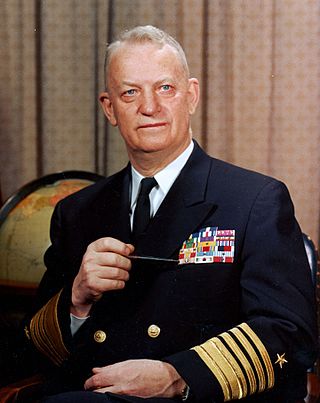
Arleigh Albert Burke was an admiral of the United States Navy who distinguished himself during World War II and the Korean War, and who served as Chief of Naval Operations during the Eisenhower and Kennedy administrations.

A warship or combatant ship is a ship that is used for naval warfare. Usually they belong to the navy branch of the armed forces of a nation, though they have also been operated by individuals, cooperatives and corporations. As well as being armed, warships are designed to withstand damage and are typically faster and more maneuverable than merchant ships. Unlike a merchant ship, which carries cargo, a warship typically carries only weapons, ammunition and supplies for its crew.

The Russian Navy is the naval arm of the Russian Armed Forces. It has existed in various forms since 1696. Its present iteration was formed in January 1992 when it succeeded the Navy of the Commonwealth of Independent States.

USS Northampton (CL/CA-26) was the lead Northampton-class cruiser in service with the United States Navy. She was commissioned in 1930, originally classified a light cruiser because of her thin armor but later reclassified a heavy cruiser because of her 8-inch guns. During World War II she served in the Pacific and was sunk by Japanese torpedoes during the Battle of Tassafaronga on 30 November 1942. She was named after the city of Northampton, Massachusetts, the home of former President Calvin Coolidge.
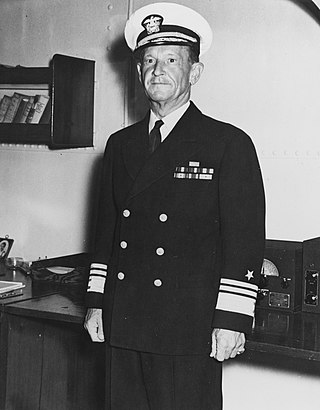
Frank Jack Fletcher was an admiral in the United States Navy during World War II. Fletcher commanded five different task forces through the war; he was the operational task force commander at the pivotal battles of the Coral Sea and Midway, which collectively resulted in the sinking of five Japanese aircraft carriers.
A destroyer squadron is a naval squadron or flotilla usually consisting of destroyers rather than other types of vessel. In some navies other vessels, such as frigates, may be included. In English the word "squadron" tends to be used for larger and "flotilla" for smaller vessels; both may be used for destroyer units. Similar formations are used in non-English-speaking countries, e.g., the "escadrille"—which would translate directly as "squadron"—in France.

Norman (Nicholas) Scott was a rear admiral in the United States Navy. He was killed along with many of his staff when the ship he was on – the light cruiser USS Atlanta – was hit by gunfire from the heavy cruiser USS San Francisco during the nighttime fighting in the Naval Battle of Guadalcanal. He was the second of five US Navy admirals killed in battle during WWII, including: Isaac C. Kidd ; Daniel J. Callaghan ; Henry M. Mullinnix ; and Theodore E. Chandler.
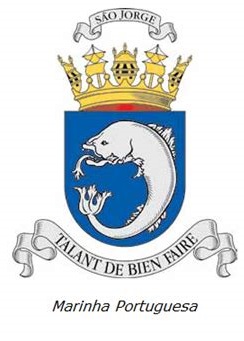
The Portuguese Navy, also known as the Portuguese War Navy or as the Portuguese Armada, is the navy of the Portuguese Armed Forces. Chartered in 1317 by King Dinis of Portugal, it is the oldest continuously serving navy in the world; in 2017, the Portuguese Navy commemorated the 700th anniversary of its official creation.
Surface combatants are a subset of naval warships which are designed for warfare on the surface of the water, with their own weapons and armed forces. They are generally ships built to fight other ships, submarines, aircraft or land targets, and can carry out several other missions including counter-narcotics operations and maritime interdiction. Their primary purpose is to engage space, air, surface, and submerged targets with weapons deployed from the ship itself, rather than by crewed carried craft.

Weapons of Choice is a science fiction novel by Australian author John Birmingham, the first in his Axis of Time alternative history trilogy.

USS Porterfield (DD-682) was a Fletcher-class destroyer of the United States Navy. Commissioned in 1943, she served in several Pacific campaigns during World War II, earning ten battle stars. She was decommissioned immediately after the end of the war but reactivated in 1951 for the Korean War, earning four more battle stars, and then served continuously until 1969. She was sunk as a target in 1982.

The Free French Naval Forces were the naval arm of the Free French Forces during the Second World War. They were commanded by Admiral Émile Muselier.
Norman Francis Vandivier was a United States Navy aviator during World War II. He was posthumously awarded the Navy Cross for action during the Battle of Midway.
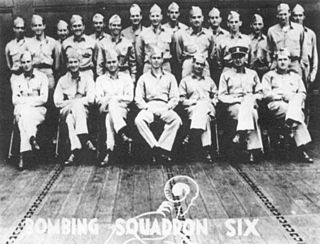
Frederick Thomas Weber was a naval aviator in the United States Navy during World War II.

SMS Danzig was a light cruiser of the Imperial German Navy. Named for the city of Danzig, she was the seventh and last ship of the Bremen class. She was begun by the Imperial Dockyard in her namesake city in 1904, launched on 23 September 1905 and commissioned on 1 December 1907. Armed with a main battery of ten 10.5 cm (4.1 in) guns and two 45 cm (18 in) torpedo tubes, Danzig was capable of a top speed of 22 knots.

SMS Augsburg was a Kolberg-class light cruiser of the German Kaiserliche Marine during the First World War. She had three sister ships, SMS Kolberg, Mainz, and Cöln. The ship was built by the Kaiserliche Werft in Kiel; her hull was laid down in 1908 and she was launched in July 1909. Augsburg was commissioned into the High Seas Fleet in October 1910. She was armed with a main battery of twelve 10.5 cm SK L/45 guns and had a top speed of 25.5 knots.
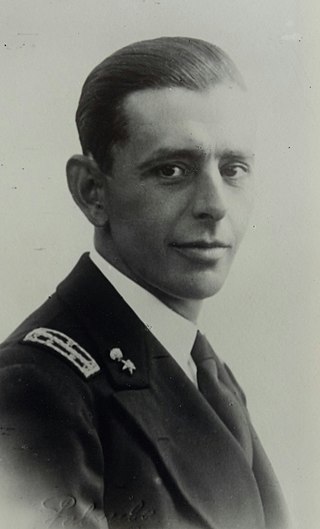
Pietro De Cristofaro was an Italian naval officer during World War II.
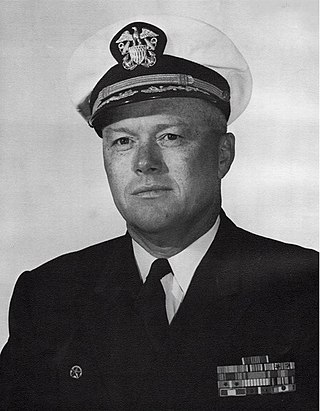
Robert Edward Adamson Jr. was a decorated commander in the United States Navy who served during World War II, the Korean War, and the Vietnam War, and reached the rank of vice admiral.
References
- ↑ Ryder, Jason (August 26, 2009). "An Exclusive Interview with Science Fiction Writer Melinda Snodgrass". Yahoo! Voices. Retrieved December 26, 2013.